Modification of Recycled Concrete Aggregate and Its Use in Concrete: An Overview of Research Progress
Abstract
1. Introduction
- Provide an overview of the physical and chemical properties of recycled concrete aggregates obtained from waste concrete.
- Review existing methods and technologies for modifying recycled aggregates, including physical, chemical, and biological approaches.
- Summarize the current state of modification techniques, evaluate their pros and cons, and propose future research directions.
2. Properties of Recycled Concrete Aggregates
2.1. Physical Properties
2.2. Chemical Properties
2.3. Mechanical Performance
2.4. Sustainability
2.5. Impact on Concrete Performance and Engineering Applications
3. Recycled Concrete Aggregate Modification Techniques
3.1. Physical Modification
3.1.1. Mechanical Grinding and Shaping
- Crushing and Sieving: This is the most fundamental and commonly used method for preparing and processing recycled aggregates. Waste concrete is crushed using crushing equipment, and then the crushed concrete is graded and reassembled through sieving equipment to obtain recycled aggregates that meet grading and physical performance requirements. For example, Wang et al. [73] found that the regenerated aggregate was prepared according to the aggregate size of 10–20 mm and 5–10 mm at a mass ratio of 2:1 to obtain continuously graded aggregate, numbered RA1. The 5–10 mm granular aggregate is screened through the 4.75 mm screen to remove the part less than 4.75 mm. After passing through the sieve, the 10–20 mm granular aggregate and the 5–10 mm granular aggregate are blended to obtain continuous graded aggregate, which is termed number RA2. The 24 h water absorption of RA1 and RA2 was 4.99% and 4.78%, respectively. The results indicated that the water absorption of regenerated aggregate decreased significantly after the removal of small particle size aggregate and fine powder below 4.75 mm by sieving. Xiao et al. [74] noted that adjusting the aggregate grading resulted in a significant reduction in the standard deviation of compressive strength for concrete, with an increase in the mean value. The histogram and curve of the normal distribution of compressive strength when the substitution rate is 60% before and after allocation are shown in Figure 6. It can be seen from the figure that manual gradation adjustment can increase the mean value of the normal distribution curve and reduce the standard deviation of the normal distribution curve, thus increasing the representative value of compressive strength. The compressive strength of recycled concrete is improved, and the dispersion of performance is effectively controlled.
- Air Separation: Air separation is based on the differences in particle size and density within recycled aggregates and relies on the action of wind to segregate particles. Heavier particles are less easily carried by the wind due to inertia, while lighter particles are more prone to being carried away by the wind, achieving particle separation. For example, Li Gen [60] subjected crushed waste concrete particles with a particle size smaller than 4.75 mm to 15 min of vibration grinding followed by air separation at a velocity of 16 m/s to obtain recycled fine aggregates that meet the required specifications.
- Vibration Mixing Pretreatment: Preprocessing recycled aggregates through abrasion and crushing within a concrete mixer can conveniently achieve mechanical grinding and shaping of recycled aggregates. Wang Bo [72] conducted experiments using two types of mixers (double-shaft mixer and planetary mixer), two mixing speeds (30 r/min and 55 r/min), and two mixing methods (vibration and regular) to mix crushed waste concrete recycled aggregates. The results show that the fracture of reclaimed aggregate is the most obvious in the double horizontal shaft mixer, followed by the vibration mixing, and the planetary mixing is the least obvious in the planetary mixer. The wear phenomenon is the most obvious in vibration stirring mode, followed by ordinary forced stirring mode, and the least wear is noted with planetary stirring. The larger the stirring speed, the longer the stirring time, and the more obvious the abrasion breaking phenomenon. As the stirring time increases, the particles that have been worn and broken will have a secondary abrasion breaking phenomenon. The wear particles can decrease the slump of recycled concrete and affect the working performance. The wear particles can improve the compressive strength of concrete only under the vibration mixing mode, while the broken particles can increase the compressive strength and slump of concrete.
3.1.2. Heat Treatment
3.1.3. Microwave or Electric Pulse Treatment

3.2. Chemical Modification
3.2.1. Acid Treatment for Adhering Mortar Removal
3.2.2. Sodium Silicate Enhancement of Adhering Mortar
3.2.3. Carbonation Reinforcement of Adhesive Mortar
3.2.4. Strengthening Recycled Aggregates with Inorganic Slurries, such as Cement, Mineral Admixtures, and Nanomaterials
3.2.5. Polymer Reinforcement of Recycled Aggregates
3.3. Microbial-Induced Carbonate Precipitation Modification
4. Conclusions and Outlook
- Consistency of Enhancement Effects: The physical and chemical properties of RCA may vary significantly due to differences in the source materials, leading to inconsistent enhancement effects reported in the literature. Therefore, it is necessary to conduct in-depth research into the changes in the properties of RCA and the mechanisms of enhancement to achieve more stable enhancement effects for practical engineering applications.
- Compatibility of Composite Materials: The compatibility between RCA and enhancement materials (such as polymers, microorganisms, etc.) is a crucial issue. Researchers need to explore the interactions between suitable enhancement materials and RCA to improve the performance and stability of composite materials.
- Long-Term Performance and Durability: While RCA enhancement techniques can improve mechanical properties in the short term, long-term performance and durability, especially at the component level, still need further investigation. Researchers should focus on the aging of materials, fatigue performance, and durability of RCA after enhancement to ensure their reliability in real-world engineering applications.
- Feasibility for Large-Scale Applications: RCA enhancement techniques need to be economically feasible and scalable for large-scale applications. Therefore, researchers should consider the scalability, cost-effectiveness, and practical implementation of enhancement techniques to promote their widespread adoption in real engineering projects.
- In-Depth Study of Strengthening Mechanisms: Further in-depth studies of the mechanism of recycled aggregate strengthening technology, including the interaction between reinforced materials and recycled aggregate and the formation mechanism of the strengthening effect, should be performed in order to reveal its basic principles and influencing factors and provide a theoretical basis for surface modification of recycled aggregate and particle grading design optimization.
- The Development of New Strengthening Materials: New strengthening materials with better compatibility, strengthening effects and environmental friendliness, such as nanomaterials, fibre materials, biomaterials, etc., should be explored to improve the technical performance and stability of recycled aggregate and reduce the production cost of recycled aggregate.
- Integration of Multi-functional Strengthening Technology: Different recycled aggregate strengthening technologies are integrated to form a multi-functional strengthening system. For example, polymer strengthening, microbial induced carbonization deposition, and other technologies should be combined to achieve a more comprehensive recycled aggregate strengthening effect that is conducive to the promotion and application of recycled aggregate in high-strength concrete, ultra-high performance concrete, and other fields.
- Sustainability and Environmental Impact Assessment: A comprehensive sustainability assessment of recycled aggregate strengthening technology should be performed considering its sustainability in terms of resource use, energy consumption, environmental impact, etc. There is also a need to study the potential environmental and human health impacts of recycled aggregate-strengthening technologies. Under the premise of not affecting the workability, mechanical properties, and durability of concrete, the highest replacement rate of recycled aggregate is studied to realize the recycling and efficient utilization of waste concrete and reduce the cost of recycled concrete.
Funding
Conflicts of Interest
References
- Kabirifar, K.; Mojtahedi, M.; Wang, C.C.; Tam, V.W. Effective construction and demolition waste management assessment through waste management hierarchy; a case of Australian large construction companies. J. Clean. Prod. 2021, 312, 12. [Google Scholar] [CrossRef]
- Arivalagan, S. Sustainable studies on concrete with GGBS as a replacement material in cement. JJCE 2014, 8, 263–270. [Google Scholar]
- Dhir, R.K.; El-Mohr, M.A.K.; Dyer, T.D. Chloride binding in GGBS concrete. Cem. Concr. Res. 1996, 26, 1767–1773. [Google Scholar] [CrossRef]
- Liu, M. Self-compacting concrete with different levels of pulverized fuel ash. Constr. Build. Mater. 2010, 24, 1245–1252. [Google Scholar] [CrossRef]
- Bampanis, I.; Vasilatos, C. Recycling Concrete to Aggregates. Implications on CO2 Footprint. Mater. Proc. 2023, 15, 28. [Google Scholar]
- Pan, Z. Fundamental and Application Research on the Utilization of Acetic Acid Modified Recycled Aggregate. Master’s Thesis, Southeast University, Dhaka, Bangladesh, 2020. [Google Scholar] [CrossRef]
- Huang, J. Study on the Fundamental Characteristics of Setting Retardant and Shrinkage-Reducing Type Ofalkali-Activated Slag Recycled Concrete. Ph.D. Thesis, Harbin Institute of Technology, Harbin, China, 2022. [Google Scholar]
- Ge, X. Research on Application of Salvaged Materials and Regenerative Materials in the Context of Resource-Efficient Landscape. Ph.D. Thesis, Beijing Forestry University, Beijing, China, 2014. [Google Scholar]
- Wang, Y.; Qin, L.; Li, S. Research progress on modification technology of construction waste recycled aggregates. China Concr. Cem. Prod. 2022, 9, 99–105. [Google Scholar] [CrossRef]
- Wang, B.; Yan, L.; Fu, Q.; Kasal, B. A Comprehensive Review on Recycled Aggregate and Recycled Aggregate Concrete. Resour. Conserv. Recycl. 2021, 171, 105565. [Google Scholar] [CrossRef]
- Santiago, R.; Lima, L.; Leite, B.; Filho, D. Mechanical behavior of recycled lightweight concrete using EVA waste and CDW under moderate temperature. Rev. IBRACON Estrut. Mater. 2009, 2, 211–221. [Google Scholar] [CrossRef]
- Phutthimethakul, L.; Kumpueng, P.; Supakata, N. Use of flue gas desulfurization gypsum, construction and demolition waste, and oil palm waste trunks to produce concrete bricks. Crystals 2020, 10, 709. [Google Scholar] [CrossRef]
- Esquinas, R. Mechanical and durability performance of mortars with fine recycled concrete aggregates and reactive magnesium oxide as partial cement replacement. Cem. Concr. Compos. 2020, 105, 103420. [Google Scholar] [CrossRef]
- Ginga, P.; Ongpeng, C.; Daly, M. Circular economy on construction and demolition waste. Materials 2020, 13, 2970. [Google Scholar] [CrossRef] [PubMed]
- Wang, J.; Wu, H.; Tam, V.W.; Zuo, J. Considering life-cycle environmental impacts and society’s willingness for optimizing construction and demolition waste management fee: An empirical study of China. J. Clean. Prod. 2019, 206, 1004–1014. [Google Scholar] [CrossRef]
- Zhang, W.; Yuan, Z.; Li, D. Mechanical and vegetation performance of porous concrete with recycled aggregate in riparian buffer area. J. Clean. Prod. 2022, 332, 130015. [Google Scholar] [CrossRef]
- Wang, C.; Xiao, J.; Qi, C.; Li, C. Rate sensitivity analysis of structural behaviors of recycled aggregate concrete frame. J. Build. Eng. 2022, 45, 103634. [Google Scholar] [CrossRef]
- Gao, D.; Yan, H.; Yang, L.; Pang, Y.; Sun, B. Analysis of bond performance of steel bar in steel-polypropylene hybrid fiber reinforced concrete with partially recycled coarse aggregates. J. Clean. Prod. 2022, 370, 133528. [Google Scholar] [CrossRef]
- Yan, H.; Gao, D.; Guo, A.; Zhang, Y. Monotonic and cyclic bond responses of steel bar with steel-polypropylene hybrid fiber reinforced recycled aggregate concrete. Constr. Build. Mater. 2022, 327, 127031. [Google Scholar] [CrossRef]
- Hosseinnezhad, H.; Sürmelioğlu, S.; Çakır, Ö.A.; Ramyar, K. A novel method for characterization of recycled concrete aggregates: Computerized microtomography. J. Build. Eng. 2023, 76, 107321. [Google Scholar] [CrossRef]
- Younis, K.H. Influence of sodium hydroxide (NaOH) molarity on fresh properties of self-compacting slag-based geopolymer concrete containing recycled aggregate. Mater. Today: Proc. 2021, 56, 1733–1737. [Google Scholar] [CrossRef]
- Nematzadeh, M.; Nazari, A.; Tayebi, M. Post-fire impact behavior and durability of steel fiber-reinforced concrete containing blended cement–zeolite and recycled nylon granules as partial aggregate replacement. Arch. Civ. Mech. Eng. 2021, 1, 5. [Google Scholar] [CrossRef]
- Munir, M.J.; Kazmi, S.M.S.; Wu, Y.; Patnaikuni, I.; Wang, J.; Wang, Q. Development of a unified model to predict the axial stress–strain behavior of recycled aggregate concrete confined through spiral reinforcement. Eng. Struct. 2020, 218, 110851. [Google Scholar] [CrossRef]
- Wu, H.; Liang, C.; Zhang, Z. Utilizing heat treatment for making low-quality recycled aggregate into enhanced recycled aggregate, recycled cement and their fully recycled concrete. Constr. Build. Mater. 2023, 394, 132126. [Google Scholar] [CrossRef]
- Feng, C.; Huang, Y.; Cui, B.; Zhu, J.; Li, D.; Guo, H. Research progress on treatment methods of building recycled concrete aggregates. Mater. Introd. 2022, 36, 84–91. [Google Scholar]
- Bao, J.; Li, S.; Zhang, P.; Ding, X.; Xue, S.; Cui, Y.; Zhao, T. Influence of the incorporation of recycled coarse aggregate on water absorption and chloride penetration into concrete. Constr. Build. Mater. 2020, 239, 117845. [Google Scholar] [CrossRef]
- Khaliq, W.; Taimur. Mechanical and physical response of recycled aggregates high-strength concrete at elevated temperatures. Fire Saf. J. 2018, 96, 203–214. [Google Scholar] [CrossRef]
- Wang, C.; Xiao, J. Evaluation of the stress-strain behavior of confined recycled aggregate concrete under monotonic dynamic loadings. Cem. Concr. Compos. 2018, 87, 149–163. [Google Scholar] [CrossRef]
- Li, J.; Yang, E. Macroscopic and microstructural properties of engineered cementitious composites incorporating recycled concrete fines. Cem. Concr. Compos. 2017, 78, 33–42. [Google Scholar] [CrossRef]
- Reis, G.S.D.; Quattrone, M.; Ambros, W.M.; Grigore Cazacliu, B.; Hoffmann Sampaio, C. Current Applications of Recycled Aggregates from Construction and Demolition: A Review. Materials 2021, 14, 1700. [Google Scholar] [CrossRef]
- Huang, B.; Wang, X.; Kua, H.; Geng, Y.; Bleischwitz, R.; Ren, J. Construction and demolition waste management in China through the 3R principle. Resour. Conserv. Recycl. 2018, 129, 36–44. [Google Scholar] [CrossRef]
- Jones, R.; Zheng, L.; Yerramala, A.; Rao, K.S. Use of recycled and secondary aggregates in foamed concretes. Mag. Concr. Res. 2012, 64, 513–525. [Google Scholar] [CrossRef]
- Rahardjo, H.; Satyanaga, A.; Harnas, F.R.; Leong, E.C. Use of Dual Capillary Barrier as Cover System for a Sanitary Landfill in Singapore. Indian Geotech. J. 2016, 46, 228–238. [Google Scholar] [CrossRef]
- Rahman, M.A.; Imteaz, M.; Arulrajah, A.; Disfani, M.M. Suitability of recycled construction and demolition aggregates as alternative pipe backfilling materials. J. Clean. Prod. 2014, 66, 75–84. [Google Scholar] [CrossRef]
- Favaretto, P.; Hidalgo, G.E.N.; Sampaio, C.H.; Silva, R.D.A.; Lermen, R.T. Characterization and Use of Construction and Demolition Waste from South of Brazil in the Production of Foamed Concrete Blocks. Appl. Sci. 2017, 7, 1090. [Google Scholar] [CrossRef]
- Poon, C.S.; Lam, C.S. The effect of aggregate-to-cement ratio and types of aggregates on the properties of pre-cast concrete blocks. Cem. Concr. Compos. 2008, 30, 283–289. [Google Scholar] [CrossRef]
- Vieira, C.S.; Pereira, P.M. Use of recycled construction and demolition materials in geotechnical applications: A review. Resour. Conserv. Recycl. 2015, 103, 192–204. [Google Scholar] [CrossRef]
- Yeung, A.T.; Mok, K.; Tham, L.; Lee, P.; Pei, G. Use of inert C&D materials for seawall foundation: A field-scale pilot test. Resour. Conserv. Recycl. 2006, 47, 375–393. [Google Scholar] [CrossRef]
- Allahverdi, A.; Kani, E.N. Construction wastes as raw materials for geopolymer binders. Int. J. Civ. Eng. 2009, 7, 154–160. [Google Scholar]
- Poon, C.-S.; Kou, S.-C.; Wan, H.-W.; Etxeberria, M. Properties of concrete blocks prepared with low grade recycled aggregates. Waste Manag. 2009, 29, 2369–2377. [Google Scholar] [CrossRef]
- Komnitsas, K.; Zaharaki, D.; Vlachou, A.; Bartzas, G.; Galetakis, M. Effect of synthesis parameters on the quality of construction and demolition wastes (CDW) geopolymers. Adv. Powder Technol. 2015, 26, 368–376. [Google Scholar] [CrossRef]
- Vásquez, A.; Cárdenas, V.; Robayo, R.A.; de Gutiérrez, R.M. Geopolymer based on concrete demolition waste. Adv. Powder Technol. 2016, 27, 1173–1179. [Google Scholar] [CrossRef]
- Sagheer, A.M.; Tabsh, S.W.; Yehia, S. The Structural Behavior of Reinforced Concrete Beams Made with Locally Produced Recycled Aggregate in the UAE. Buildings 2023, 13, 10. [Google Scholar] [CrossRef]
- Tabsh, S.W.; Abdelfatah, A.S. Influence of recycled concrete aggregates on strength properties of concrete. Constr. Build. Mater. 2009, 23, 1163–1167. [Google Scholar] [CrossRef]
- Yehia, S.; Helal, K.; Abusharkh, A.; Zaher, A.; Istaitiyeh, H. Strength and Durability Evaluation of Recycled Aggregate Concrete. Int. J. Concr. Struct. Mater. 2015, 9, 219–239. [Google Scholar] [CrossRef]
- Yehia, S.; Abdelfatah, A. Examining the Variability of Recycled Concrete Aggregate Properties. In Proceedings of the International Conference on Civil, Architecture and Sustainable Development (CASD-2016), London, UK, 1–2 December 2016. [Google Scholar] [CrossRef]
- Zhao, G.; Zhu, Z.; Ren, G.; Wu, T.; Ju, P.; Ding, S.; Shi, M.; Fan, H. Utilization of recycled concrete powder in modification of the dispersive soil: A potential way to improve the engineering properties. Constr. Build. Mater. 2023, 389, 131626. [Google Scholar] [CrossRef]
- Ye, T.; Xiao, J.; Duan, Z.; Li, S. Geopolymers made of recycled brick and concrete powder–A critical review. Constr. Build. Mater. 2022, 330, 127232. [Google Scholar] [CrossRef]
- Bao, J.; Li, S.; Zhang, P.; Zhao, T. Effect of recycled coarse aggregate after strengthening by silane impregnation on mass transport of concrete. J. Compos. Mater. 2020, 10, 2602–2609. [Google Scholar] [CrossRef]
- Feng, C.; Cui, B.; Huang, Y.; Guo, H.; Zhang, W.; Zhu, J. Enhancement technologies of recycled aggregate–enhancement mechanism, influencing factors, improvement effects, technical difficulties, life cycle assessment. Constr. Build. Mater. 2022, 317, 126168. [Google Scholar] [CrossRef]
- Sabbà, M.F.; Tesoro, M.; Falcicchio, C.; Foti, D. Rammed Earth with Straw Fibers and Earth Mortar: Mix Design and Mechanical Characteristics Determination. Fibers 2021, 9, 30. [Google Scholar] [CrossRef]
- Foti, D.; Cavallo, D. Mechanical behavior of concretes made with non-conventional organic origin calcareous aggregates. Constr. Build. Mater. 2018, 179, 100–106. [Google Scholar] [CrossRef]
- Foti, D.; Lerna, M.; Randl, N. New Mortar Mixes with Chemically Depolymerized Waste PET Aggregates. Adv. Mater. Sci. Eng. 2020, 2020, 1–9. [Google Scholar] [CrossRef]
- Foti, D. 18–Recycled Waste PET for Sustainable Fiber-Reinforced Concrete. In Use of Recycled Plastics in Eco-efficient Concrete; Pacheco-Torgal, F., Khatib, J., Colangelo, F., Tuladhar, R., Eds.; Woodhead Publishing: Sawston, UK, 2019; pp. 387–410. [Google Scholar]
- Ferraro, A.; Ducman, V.; Colangelo, F.; Korat, L.; Spasiano, D.; Farina, I. Production and characterization of lightweight aggregates from municipal solid waste incineration fly-ash through single- and double-step pelletization process. J. Clean. Prod. 2023, 383, 135275. [Google Scholar] [CrossRef]
- Farina, I.; Moccia, I.; Salzano, C.; Singh, N.; Sadrolodabaee, P.; Colangelo, F. Compressive and Thermal Properties of Non-Structural Lightweight Concrete Containing Industrial Byproduct Aggregates. Materials 2022, 15, 4029. [Google Scholar] [CrossRef]
- Kou, S.C.; Poon, C.S. Properties of self-compacting concrete prepared with coarse and fine recycled concrete aggregates. Cem. Concr. Compos. 2009, 9, 622–627. [Google Scholar] [CrossRef]
- Wang, C.; Xiao, J.; Li, C. Strain rate effect analysis on characteristic parameters of restoring force for recycled aggregate concrete frame structures. J. Civ. Eng. 2021, 8, 24–36. [Google Scholar] [CrossRef]
- Wang, C.; Xiao, J.; Li, Q. Experimental study on mechanical behavior of confined recycled aggregate concrete under cyclic loadings. J. Build. Struct. 2020, 41, 436–442. [Google Scholar] [CrossRef]
- Xiao, J.; Lin, Z.; Zhu, J. Effects of recycled aggregates’ gradation on compressive strength of concrete. J. Sichuan Univ. 2014, 4, 154–160. [Google Scholar] [CrossRef]
- Afshar, T.; Disfani, M.M.; Arulrajah, A.; Narsilio, G.A.; Emam, S. Impact of particle shape on breakage of recycled construction and demolition aggregates. Powder Technol. 2017, 308, 1–12. [Google Scholar] [CrossRef]
- Xiao, J.; Li, W.; Sun, Z.; Lange, D.A.; Shah, S.P. Properties of interfacial transition zones in recycled aggregate concrete tested by nanoindentation. Cem. Concr. Compos. 2013, 37, 276–292. [Google Scholar] [CrossRef]
- Wang, L. The Effect and Mechanism of Construction Solid Waste Powder on the Properties of Cement-Based Materials at the Micro-Nano Scale. Master’s Thesis, Guangzhou University, Guangzhou, China, 2021. [Google Scholar] [CrossRef]
- Zhou, C.; Ji, H.; Zhao, L. Application and research progress of recycled micro-powders in cement-based materials. Bull. Chin. Ceram. Soc. 2019, 8, 2456–2463. [Google Scholar] [CrossRef]
- Li, W.; Liu, X. Research on factors affecting mechanical property of regenerated aggregate concrete. Archit. Technol. 2012, 1, 15–17. [Google Scholar]
- Zhang, T.; Chen, M.; Wang, Y.; Zhang, M. Roles of carbonated recycled fines and aggregates in hydration, microstructure and mechanical properties of concrete: A critical review. Cem. Concr. Compos. 2023, 138, 104994. [Google Scholar] [CrossRef]
- Duan, Z.; Hou, S.; Pan, Z.; Jiang, S.; Xiao, J. Rheology of recycled fine aggregate concrete and its effect on strength and durability. J. Build. Struct. 2020, 41, 420–426. [Google Scholar] [CrossRef]
- Xie, T.; Zhao, X. Can a local bond test truly reflect impact of recycled aggregate on the bond between deformed steel bars and recycled aggregate concrete?—A critical assessment and development of a generic model. Eng. Struct. 2021, 244, 112826. [Google Scholar] [CrossRef]
- Pandurangan, K.; Dayanithy, A.; Prakash, S.O. Influence of treatment methods on the bond strength of recycled aggregate concrete. Constr. Build. Mater. 2016, 120, 212–221. [Google Scholar] [CrossRef]
- Laserna, S.; Montero, J. Influence of natural aggregates typology on recycled concrete strength. Constr. Build. Mater. 2016, 115, 78–86. [Google Scholar] [CrossRef]
- Saravanakumar, P.; Abhiram, K.; Manoj, B. Properties of treated recycled aggregates and its influence on concrete strength characteristics. Constr. Build. Mater. 2016, 111, 611–617. [Google Scholar] [CrossRef]
- Wang, B. Effect of Vibration Mixing on Attrition and Cleavage of Recycled Aggregate and Performance of Recycled Aggregate Concrete. Master’s Thesis, Chang’an University, Chang’an, China, 2019. [Google Scholar]
- Wang, Y.; Li, R.; Zhu, C.; Lan, M. Influence of strengthening treatment on physical properties of recycled coarse aggregate. Concrete 2021, 2, 82–85. [Google Scholar] [CrossRef]
- Li, G. Research on the Preparation Technology of High-Quality Recycled Aggregate and the Activation of Cement Stone Powder. Master’s Thesis, Kunming University of Science and Technology, Kumming, China, 2016. [Google Scholar]
- Xiao, J.; Wu, L.; Fan, Y. Modification test of recycled coarse aggregate by microwave heating. Concrete 2012, 7, 55–57. [Google Scholar] [CrossRef]
- Tsujino, M.; Noguchi, T.; Kitagaki, R.; Nagai, H. Completely recyclable concrete of aggregate-recovery type by a new technique using aggregate coating. J. Struct. Constr. Eng. 2010, 75, 17–24. [Google Scholar] [CrossRef][Green Version]
- Ong, K.C.G.; Akbarnezhad, A. Microwave-Assisted Concrete Technology: Production, Demolition and Recycling. In Microwave-Assisted Concrete Technology Production, Demolition and Recycling; CRC Press: Boca Raton, FL, USA, 2014. [Google Scholar]
- Shao, Z.; Zhang, P.; Wei, W.; Chen, W.; Zhang, H. Influence of moisture content on concrete mechanical properties under microwave irradiation. Adv. Eng. Sci. 2021, 6, 93–102. [Google Scholar] [CrossRef]
- Du, W. Research on Selection Technology of High Quality Recycled Concrete Aggregate. Master’s Thesis, Xi’an University of Science and Technology, Xi’an, China, 2017. [Google Scholar]
- Dai, J.; Li, C.; Yang, F.; Shi, B. Effect of different moisture content on weakening strength of rock under microwave irradiation. Water Power 2018, 40, 31–34. [Google Scholar]
- Lu, G.; Li, Y.; Hassani, F.; Zhang, X. Experimental and theoretical research progress of microwave assisted mechanical rock breaking. Chin. J. Geotech. Eng. 2016, 8, 1497–1506. [Google Scholar] [CrossRef]
- Menard, Y.; Bru, K.; Touze, S.; Lemoign, A.; Poirier, J.; Ruffie, G.; Bonnaudin, F.; Von Der Weid, F. Innovative process routes for a high-quality concrete recycling. Waste Manag. 2013, 33, 1561–1565. [Google Scholar] [CrossRef] [PubMed]
- Ma, S.; Niu, Z.; Liu, Y.; Wang, P. Research progress on performance enhancement of recycled aggregate from construction waste. J. Build. Sci. Eng. 2022, 6, 1–13. [Google Scholar] [CrossRef]
- Song, X.; Bai, C. Effect of chemical enhancing agents on the properties of recycled aggregate and recycled concrete. Silicate notification 2019, 6, 1748–1754. [Google Scholar] [CrossRef]
- Liu, X.; Xie, X.; Liu, R.; Lyu, K.; Zuo, J.; Li, S.; Liu, L.; Shah, S.P. Research on the durability of nano-SiO2 and sodium silicate co-modified recycled coarse aggregate (RCA) concrete. Constr. Build. Mater. 2023, 378, 131185. [Google Scholar] [CrossRef]
- Song, B.; Yan, H.; Cui, H.; Liu, J.; Qin, H.; Wamh, J. Influence of carbonation on chloride ion penetration resistance of CO2 modified recycled aggregate concrete. Mater. Introd. 2023, 37, 147–150. [Google Scholar]
- Wang, Y.; Zhang, X.; Fang, J.; Wang, X. Mechanical properties of recycled concrete reinforced by basalt fiber and nano-silica. KSCE J. Civ. Eng. 2022, 8, 3471–3485. [Google Scholar] [CrossRef]
- Sahu, A.; Dey, T.; Chakraborty, S. Influence of nano silica on mechanical and durability characteristic of mortar made by partial replacement of natural fine aggregate with recycled fine aggregate. Silicon 2021, 12, 4391–4405. [Google Scholar] [CrossRef]
- Sadeghi-Nik, A.; Berenjian, J.; Alimohammadi, S.; Lotfi-Omran, O.; Sadeghi-Nik, A.; Karimaei, M. The effect of recycled concrete aggregates and metakaolin on the mechanical properties of self-compacting concrete containing nanoparticles. Iran. J. Sci. Technol. Trans. Civ. Eng. 2019, 43, 503–515. [Google Scholar] [CrossRef]
- Reddy, N.S.; Lahoti, M. A succinct review on the durability of treated recycled concrete aggregates. Environ. Sci. Pollut. Res. 2023, 10, 25356–25366. [Google Scholar] [CrossRef]
- Hosseini, P.; Booshehrian, A.; Madari, A. Developing concrete recycling strategies by utilization of nano-SiO2 particles. Waste Biomass Valorization 2011, 3, 347–355. [Google Scholar] [CrossRef]
- Wang, L.; Chen, Y.; Pan, W.; Sun, X. Effects of manufacture technology on compressive strength of recycled aggregate concrete. Concrete 2011, 6, 162–164. [Google Scholar]
- Li, L.; Xuan, D.; Chu, S.H.; Poon, C.S. Modification of recycled aggregate by spraying colloidal nano silica and silica fume. Mater. Struct. 2021, 54, 6. [Google Scholar] [CrossRef]
- Li, P. Properties study of polymer modified permeable bricks of recycled aggregate. New Build. Mater. 2018, 2, 137–140. [Google Scholar]
- Hua, S.; Zhang, J.; Gao, P.; Fan, D.; Zhou, A. Self-healing of concrete cracks by immobilizing non-axenic bacteria with enhanced recycled aggregates. J. Compos. Mater. 2023, 40, 1–13. [Google Scholar] [CrossRef]
- Zhang, J.; Chen, P.; Xu, H.; Ma, M.; Tao, H. Experimental study on the behavior of recycled aggregates strengthened by microbial induced carbonate precipitation. J. Zhejiang Univ. Technol. (Nat. Sci. Ed.) 2020, 1, 122–129. [Google Scholar]
- Xue, L. Research on Key Problems of Recycled Concrete Application in Northern Marine Environment. Master’s Thesis, Dalian University of Technology, Dalian, China, 2022. [Google Scholar] [CrossRef]
- Makul, N.; Rattanadecho, P.; Agrawal, D.K. Applications of microwave energy in cement and concrete–A review. Renew. Sustain. Energy Rev. 2014, 37, 715–733. [Google Scholar] [CrossRef]
- Kim, K.H.; Cho, H.C.; Ahn, J.W. Breakage of waste concrete for liberation using autogenous mill. Miner. Eng. 2012, 35, 43–45. [Google Scholar] [CrossRef]
- Hu, Z.; Li, G.; Ouyang, M. Research progress of waste concrete recycling. Commer. Concr. 2016, 1, 30–32. [Google Scholar]
- Masato, T.; Takafumi, N.; Masaki, T.; Manabu, K.; Ippei, M. Application of conventionally recycled coarse aggregate to concrete structure by surface modification treatment. J. Adv. Concr. Technol. 2007, 5, 13–25. [Google Scholar] [CrossRef]
- Liu, Z.; Qin, H. Technique for improvement of mechanical properties of recycled concrete and its application. Adv. Sci. Technol. Water Resour. 2017, 1, 90–94. [Google Scholar] [CrossRef]

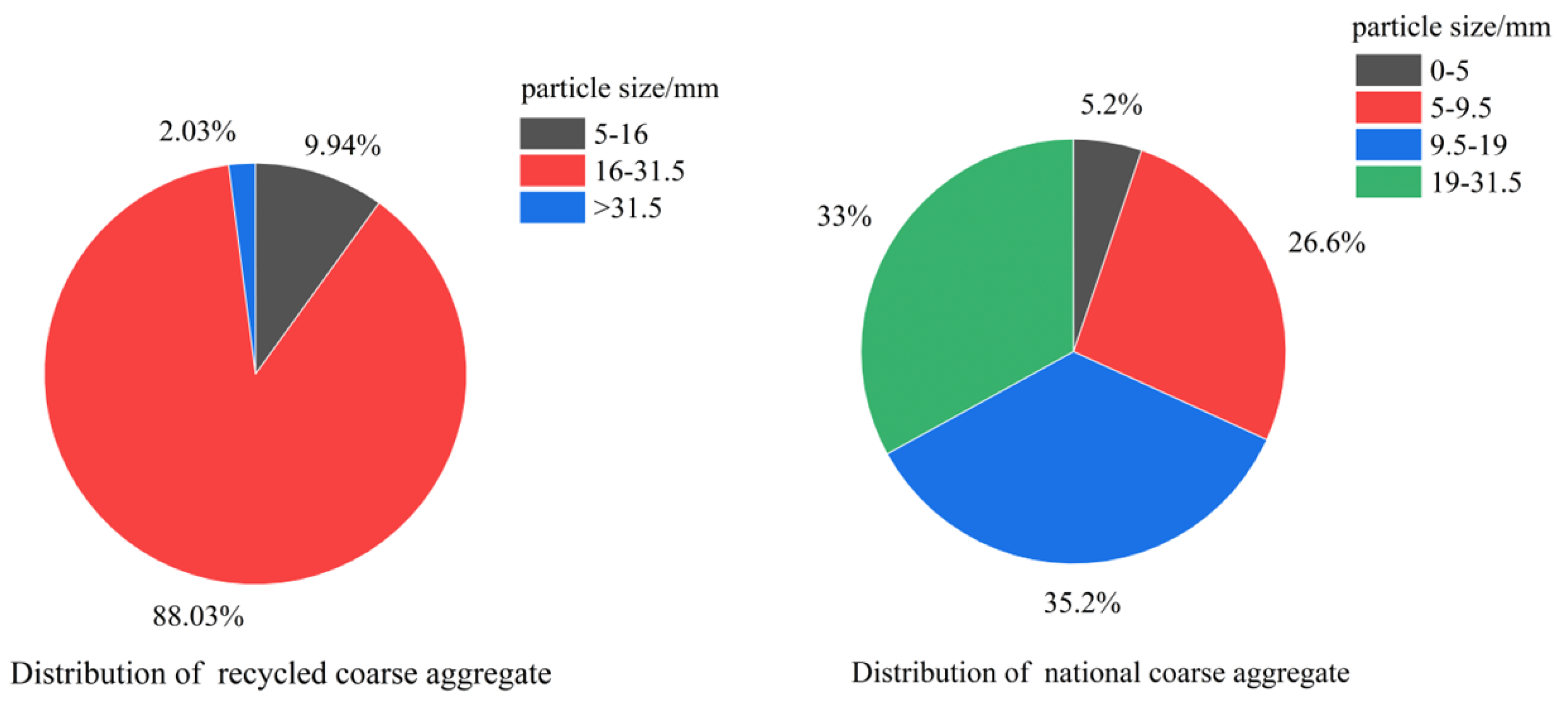
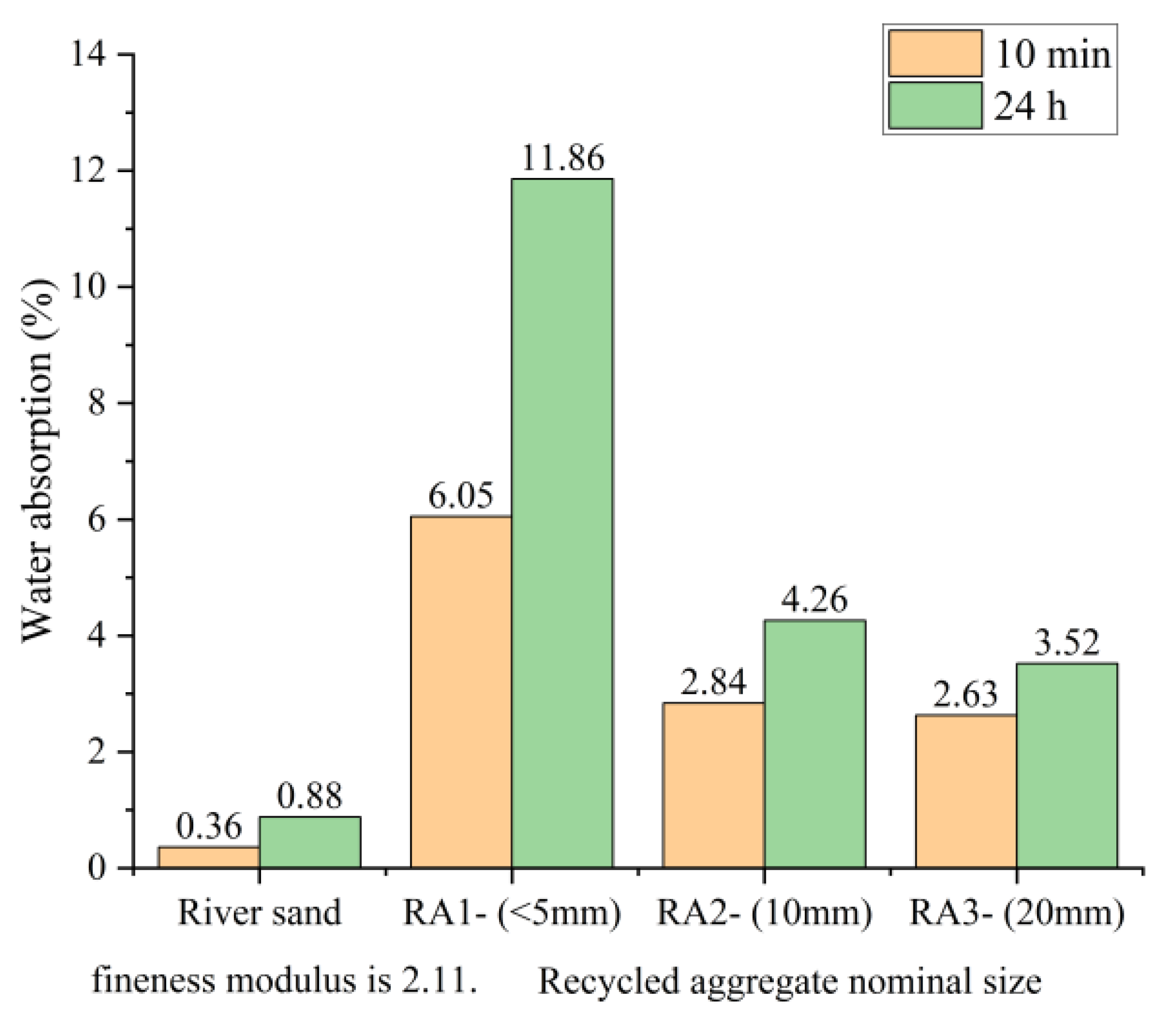
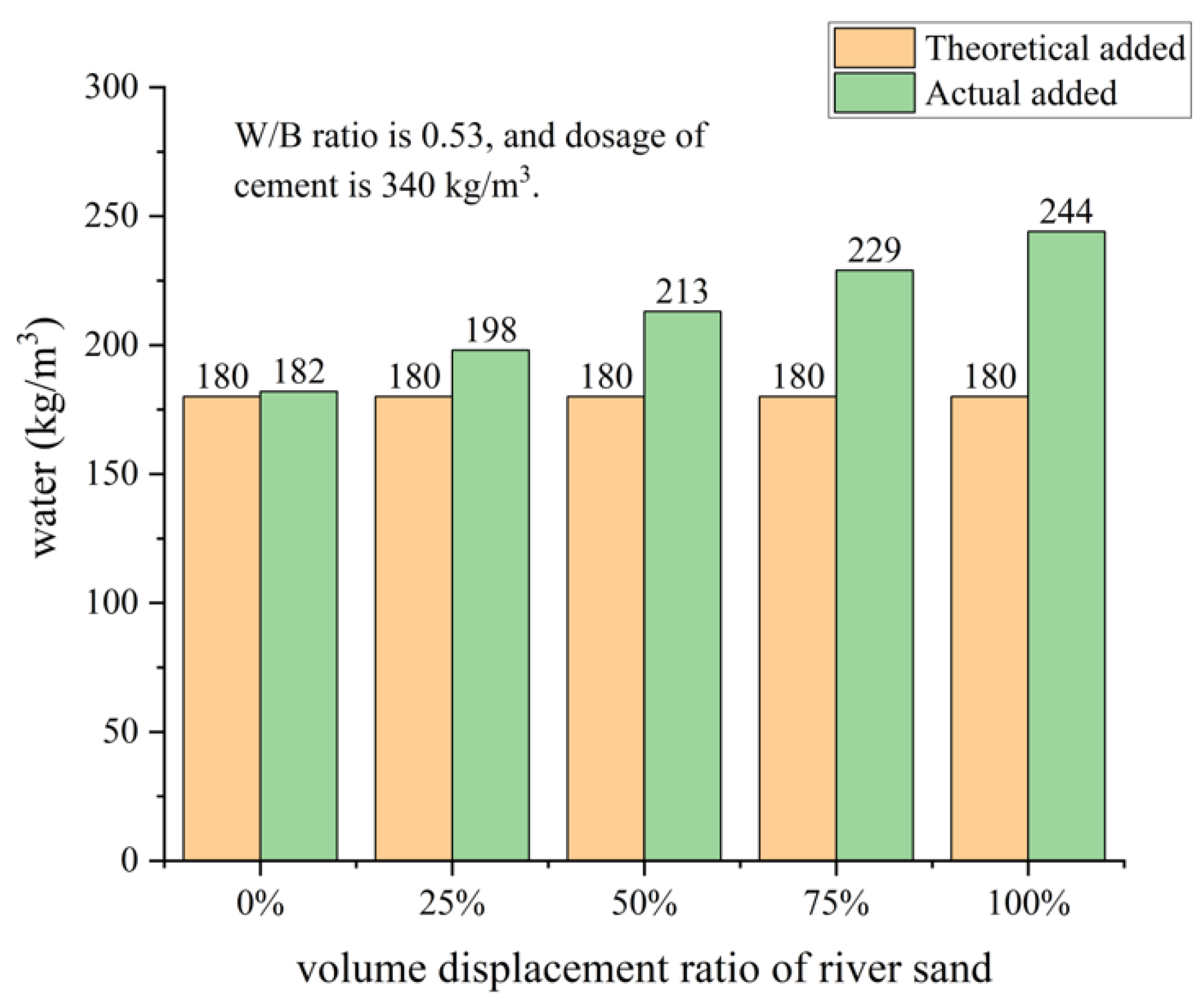
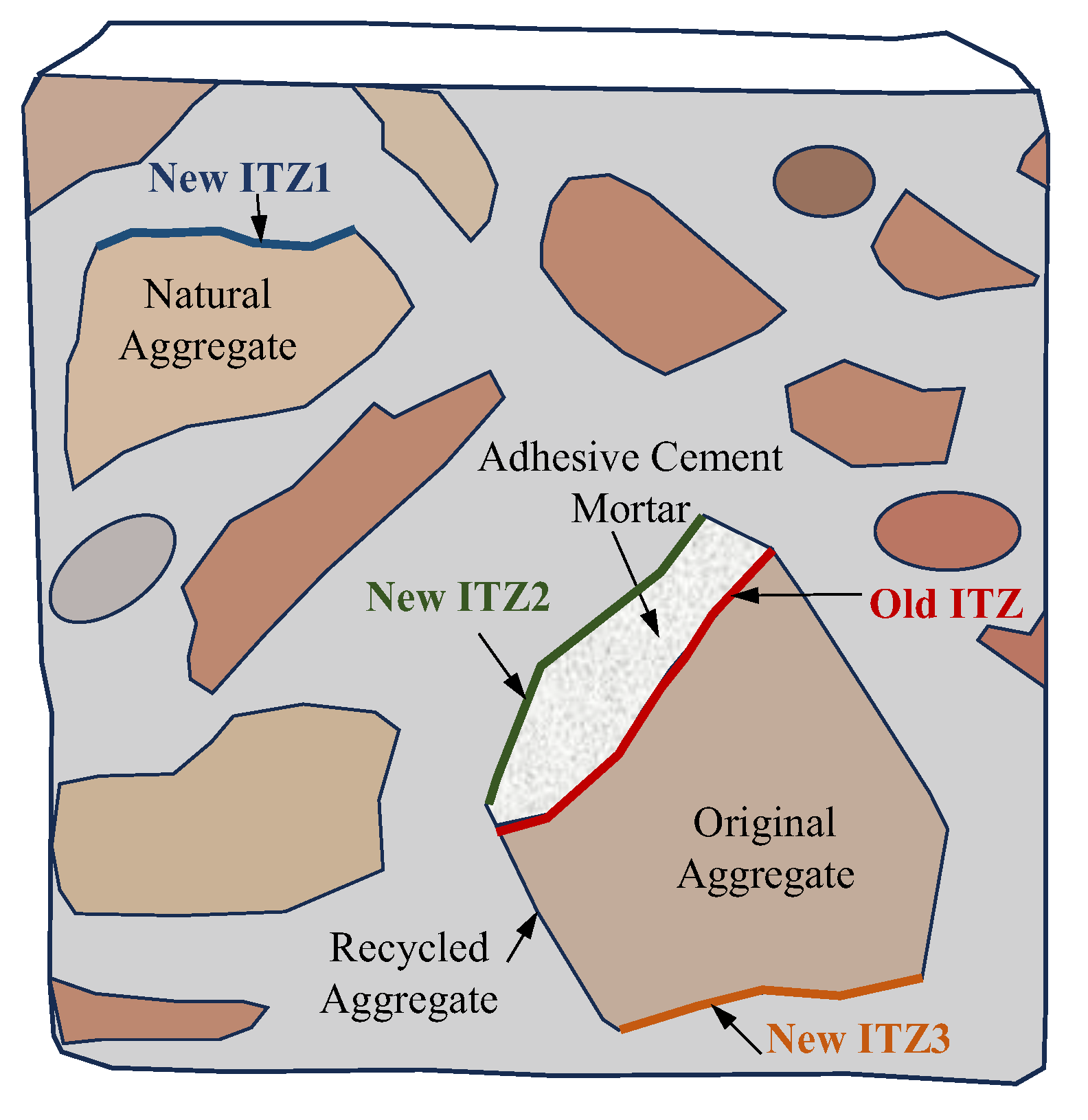
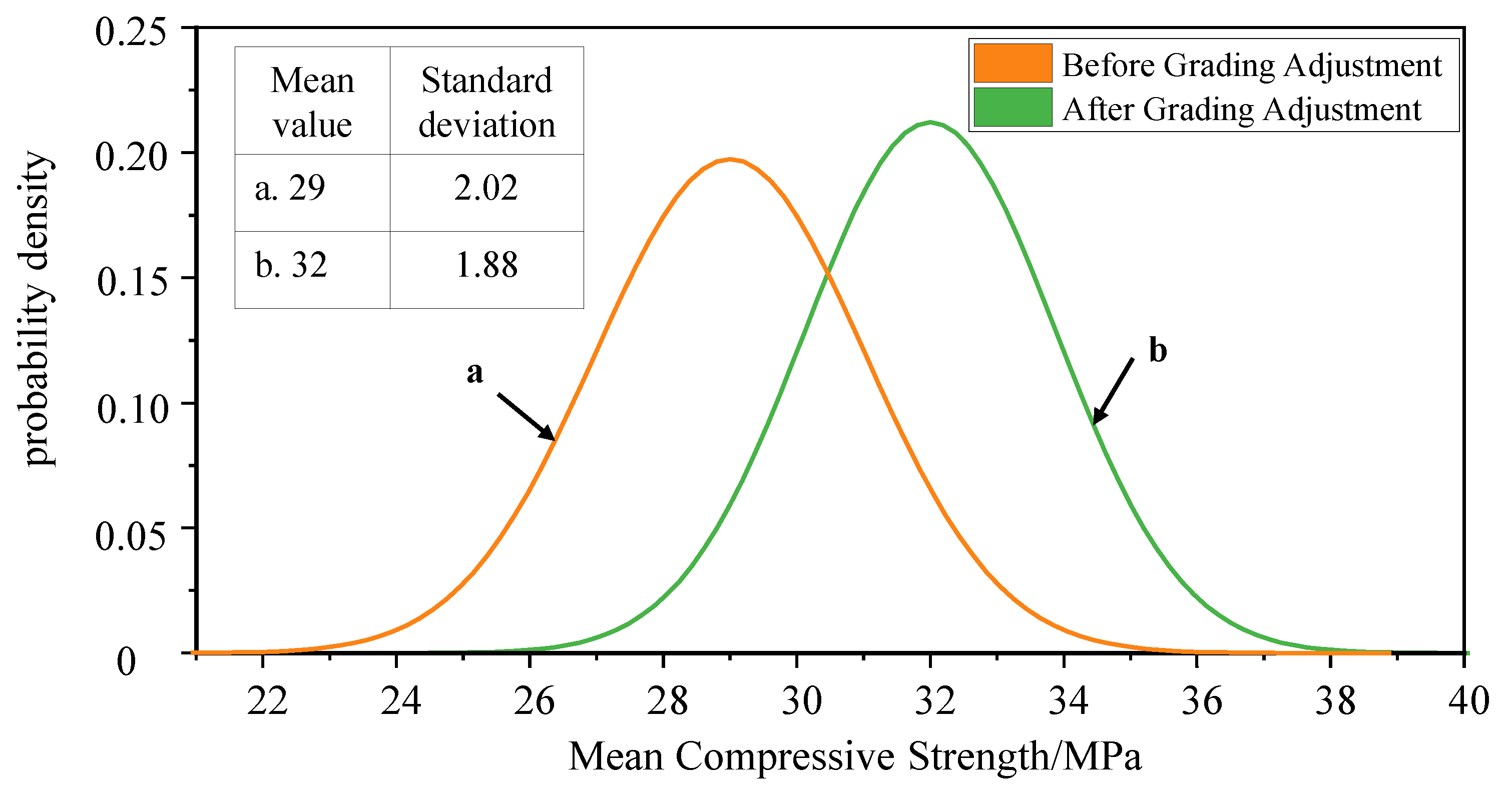
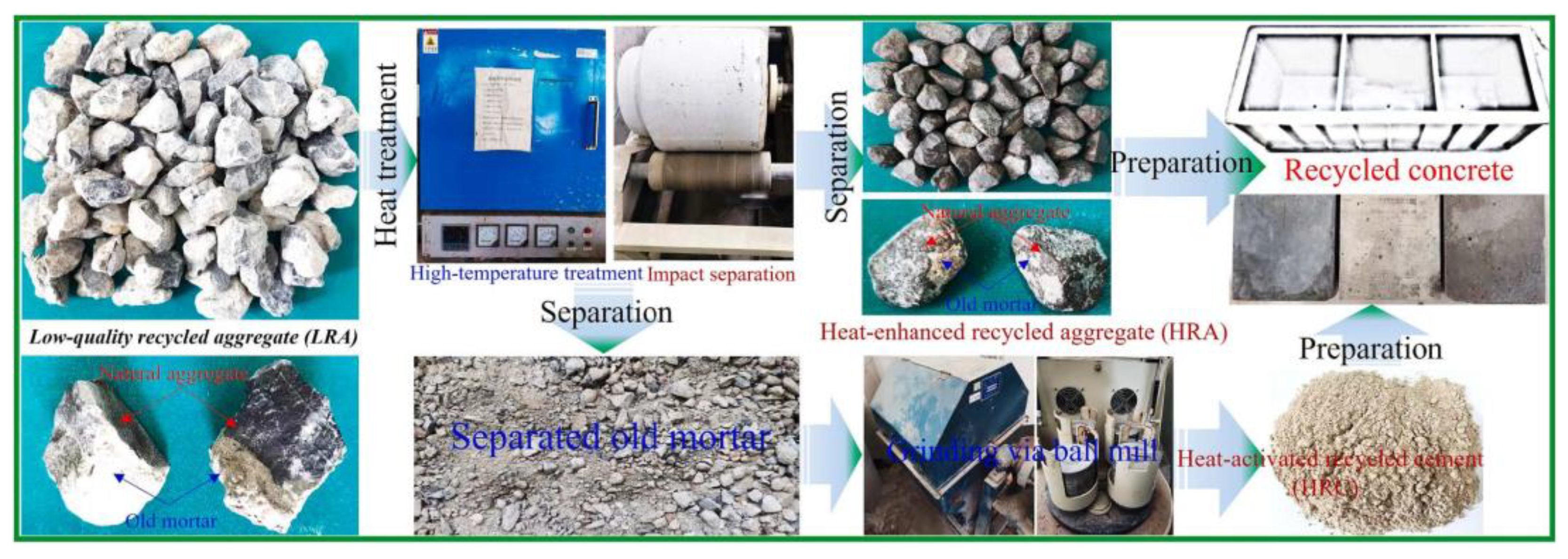




| Region | Countries | Indirect CO2 Reduction (Mt) |
|---|---|---|
| North America | Canada | 45.5 |
| United States | 464.9 | |
| Mexico | 5.9 | |
| Latin America | Brazil | 53.5 |
| Europe | Germany | 226.9 |
| United Kingdom | 106.6 | |
| Netherlands | 28.8 | |
| Belgium | 16.2 | |
| France | 298.6 | |
| Spain | 41.6 | |
| Turkey | 14.9 | |
| Russia | 43.2 | |
| Africa | Guinea | 20.3 |
| South Africa | 17.9 | |
| Asia | China | 1603.7 |
| India | 175.2 | |
| Japan | 149.6 | |
| South Korea | 42.0 | |
| Saudi Arabia | 5.0 | |
| Indonesia | 18.8 | |
| Oceania | Australia | 107.7 |
Disclaimer/Publisher’s Note: The statements, opinions and data contained in all publications are solely those of the individual author(s) and contributor(s) and not of MDPI and/or the editor(s). MDPI and/or the editor(s) disclaim responsibility for any injury to people or property resulting from any ideas, methods, instructions or products referred to in the content. |
© 2023 by the authors. Licensee MDPI, Basel, Switzerland. This article is an open access article distributed under the terms and conditions of the Creative Commons Attribution (CC BY) license (https://creativecommons.org/licenses/by/4.0/).
Share and Cite
Su, Y.; Yao, Y.; Wang, Y.; Zhao, X.; Li, L.; Zhang, J. Modification of Recycled Concrete Aggregate and Its Use in Concrete: An Overview of Research Progress. Materials 2023, 16, 7144. https://doi.org/10.3390/ma16227144
Su Y, Yao Y, Wang Y, Zhao X, Li L, Zhang J. Modification of Recycled Concrete Aggregate and Its Use in Concrete: An Overview of Research Progress. Materials. 2023; 16(22):7144. https://doi.org/10.3390/ma16227144
Chicago/Turabian StyleSu, Yingqiang, Yuchong Yao, Yang Wang, Xuan Zhao, Li Li, and Jie Zhang. 2023. "Modification of Recycled Concrete Aggregate and Its Use in Concrete: An Overview of Research Progress" Materials 16, no. 22: 7144. https://doi.org/10.3390/ma16227144
APA StyleSu, Y., Yao, Y., Wang, Y., Zhao, X., Li, L., & Zhang, J. (2023). Modification of Recycled Concrete Aggregate and Its Use in Concrete: An Overview of Research Progress. Materials, 16(22), 7144. https://doi.org/10.3390/ma16227144







